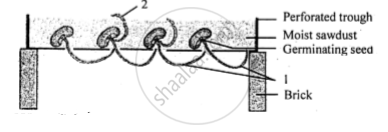Advertisements
Advertisements
प्रश्न
Name the molecules which are called assimilatory power? Why are they called so?
उत्तर
ATP and NADPH2 are called assimilatory power. They are called so because they provide the energy requirement for CO2 assimilation during the dark reaction of photosynthesis.
APPEARS IN
संबंधित प्रश्न
The individual flattened stacks of membranous structures inside the chloroplasts are known as :
A. Grana
B. Stroma
C. Thylakoids
D. Cristae
The diagram below shows two test-tubes A and B. Test-tube A contains a green water plant. Test-tube B contains both a green water plant and a snail. Both testtubes are kept in sunlight. Answer the questions that follow:

(i) Name the physiological process that releases the bubbles of oxygen.
(ii) Explain the physiological process as mentioned above in Q2 (a)(i).
(iii) What is the purpose of keeping a snail in test-tube ‘B’?
(iv) Why does test-tube ‘B’ have more bubbles of oxygen?
(v) Given an example of a water plant that can be used in the above process.
(vi) Write the overall chemical equation for the above process.
The figure given below represents an experimental setup with a weighing machine to demonstrate a particular process in plants. The experimental setup was placed in bright sunlight. Study the diagram and answer the following questions:

(i) Name the process intended for study.
(ii) Define the above mentioned process.
(iii) When the weight of the test tube (A & B) is taken before and after the experiment, what is observed? Give reasons to justify your observation in A & B.
(iv) What is the purpose of keeping the test tube B in the experimental setup?
Given below is an experiment setup to demonstrate a particualr tropic movement in germinating seeds. Study the diagram and answer the questions that follow :
Part 1 is affected by two stimuli. Name them. Which one of the two is stronger? 
Part 1 is affected by two stimuli. Name them. Which one of the two is stronger?
The diagram given below represents an experiment to prove the importance of a factor in photosynthesis. Answer the questions that follow :
Give a balanced chemical equation to represent the process of photosynthesis.
The figure given below is for performing an experiment on photosynthesis.

Answer the following:
(i) What is the aim of this experiment?
(ii) Describe an experiment to show that light is necessary for photosynthesis.
(iii) What do you conclude from this experiment?
(iv) What is the role of light in photosynthesis?
Give technical term:
Which process is the ultimate source of energy for all living organisms?
Complete the following sentence with appropriate word:
A light reaction is a ___________ reaction.
Mention, if the following statement is True or False. If false rewrite the wrong statement in its correct form:
Leaves are broad and flat to increase the surface area for photosynthesis.
Mention, if the following statement is True or False. If false rewrite the wrong statement in its correct form:
The dark reaction of Photosynthesis is light-independent.
Choose the Correct Answer:
NADP is expanded as
What will happen if we remove the fish from the aquarium and keep it (with green plants) in a dark place?

______ is positively hydrotropic as well as positively geotropic.
The green pigment present in the plant is ______.
To which directional stimuli do
- roots respond
- shoots respond?
What is photosynthesis and wherein a cell does occur?
Why should the light-dependent reaction occur before the light-independent reaction?
What are primary producers?
In leaves, the food is stored in the form of ______.
1. What happens to the dandelion flower
- During the daytime?
- At night?
2. What is the phenomenon known as?
